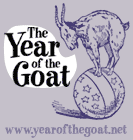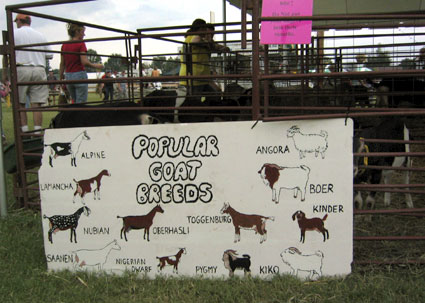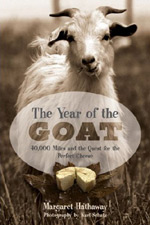COMING SOON:
- Recipes
- Event Schedule
- More Farm Updates
|

|
|

|


Some basic background information on the history, different breeds, and uses of the goat
A Brief History of Goats
Goats were one of the earliest domesticates animals, and evidence of their domestication can be traced back as far as 10,000 years. They probably originated in Central Asia and the Mediterranean, but by the 1500s Spanish and Portuguese explorers were scattering goats across the globe. Goats were commonly kept on ships as a source of milk and meat, and there's documentation that goats were along on the Mayflower's journey to America. By the 1600s, the first goat registry was produced in Switzerland, and classification by breed has existed ever since. Because of their versatility, goats have adapted to virtually every climate on the planet. Globally, more people drink goat's milk than any other type of dairy, and goat meat is one of the world's most popular red meats.
The Many Uses of Goats
Goats are used for milk, meat, fiber (or hair), land management (brush control), packing, entertainment, and pets, making them perhaps the most useful all-around animal on the planet.
Goat Breeds
All goats are ruminants, which they are animals that have four stomachs and chew their cud. There are more than 300 different breeds and types of goats in the world, many of which have been bred to specific purposes, i.e. milk, meat or fiber production. Below, we have listed some of the popular goat breeds to be found in the United States. These are also the main breeds we have encountered so far in our travels.
Dairy Goats
The following six breeds are recognized and registered by the ADGA (American Dairy Goat Association). All dairy goats, both male and female, are naturally horned, but it is customary to disbud them, removing their horns when they are young kids. This probably started as a practical measure to avoid goat horns becoming stuck or caught on the milking stand, and has evolved into a standard for any dairy goat that is being shown.
 | | Alpine doe |
Alpine: Also known as the French Alpine, these goats have erect ears and come in many different color patterns. They originated in the Alps and were brought to the United States in 1920. Alpines are very popular with commercial goat dairies because they are considered high volume milkers. According to the USDA, Alpines have the highest annual average milk production of any of the dairy breeds.
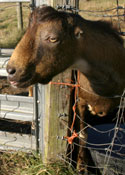 | | La Mancha buck |
La Mancha: These goats are easily recognized because they have no ears. The only breed to originate in America, they were bred in the 1930s as a cross between some mysterious short-eared does and some registered Swiss and Nubian bucks. La Manchas come in many colors and are very friendly and have agreeable personalities, which make them very popular.
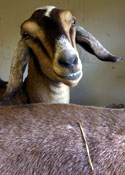 | | Nubian doe |
Nubian: This is possibly the most popular goat breed in America. Nubians have been in America since 1909, and are easy to spot because of their long ears and convex noses. (However, don't confuse them with Boer goats, which also have long ears and convex noses). Nubians are one of the larger breeds and have a reputation of being somewhat stubborn. They are very vocal (read: noisy), and have strong personalities. Nubian milk has a high butterfat content, which makes it excellent for making cheese.
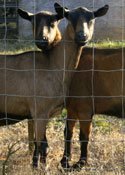 | | Oberhasli does |
Oberhasli: These goats are a distinctive dark reddish brown or "bay" color with black stripes on their faces, back, and underbelly. They don't seem to be as popular as some of the other dairy breeds (we're not sure why), but the ones we met at Devonshire Farm in Archer, Florida, were very sweet and very curious about Godfrey.
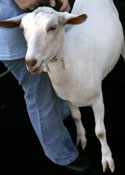 | | Saanen doe |
Saanen: These goats (pronounced SAH-nen) are almost always all white with pointy straight ears and a concave nose. They are very popular with commercial dairies because of their size and their high average of milk production. They originated in the Saane Valley of Switzerland, and were introduced to the United States in 1904.
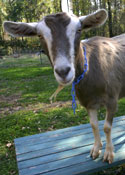 | | Toggenburg doe |
Toggenburg: Typically refered to as "Toggs," this goat, originally from Switzerland, is the oldest registered breed of goat. It can be brown or light brown and has white "reverse badger" stripes on its face and white patches on itstail and legs. Lillian Sandburg, wife of poet Carl Sandburg, had a herd of award-winning Toggenburgs, and descendants from her herd can still be visited at the Carl Sandburg Home in North Carolina.
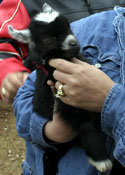 | | African Pygmy kid |
African Pygmy: This is a small breed of goat, typically kept as pets, but for their size they can produce a fair amount of milk (sometimes as much as half a gallon a day!). They were first seen in America at zoos in the 1950s, and have since grown in popularity with the public. They are stocky animals with heavy round bodies on short legs. The babies are tiny and adorable, such as Spock, the African Pygmy kid we met at the weekly goat auction in Brundidge, Alabama.
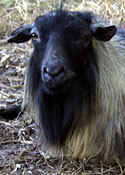 | | Nigerian Dwarf buck |
Nigerian Dwarf: A small breed like the Pygmy, the Nigerian Dwarf goat differs in that its body is proportioned similarly to some of the standard dairy breeds. Though it doesn't give as much milk as its larger counterparts, its milk is very high in butterfat. First introduced in the early 1980s in zoos, Nigerian Dwarf Goat genetics are now being worked on by serious goat breeders, and teir milk production is showing marked increases. Both the Dwarf and Pygmy goats originated in Africa, where there was great advantage in having an animal that was tiny enough to survive on a small amount of arable land, but could still provide milk for a family.
Meat Breeds
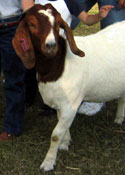 | | Boer doe |
Boer: Originally from South Africa, in recent years these goats have been the fastest growing breed in the United States. Because they are relatively new to this country--they were introduced in the mid-1990s, they are also one of the most expensive breeds. Prized purebred bucks with exemplary genetics have sold for tens of thousands of dollars. Bred for meat, they are muscular, with large, high rumps, and are typically white with brown patches, although there are some "red" Boers (actually reddish brown, some breeders find these goats even more desirable and have been trying to breed for this color). Boer goats have short curving horns that stay close to their head. Like Nubian dairy goats, Boers have long ears and convex noses, and for that reason, Nubian does are often crossed with Boer bucks to create "percentages." There are several Boer Goat associations that register Boers goats including the ABGA (American Boer Goat Association) and the IBGA (International Boer Goat Association).
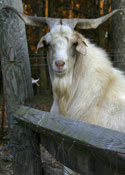 | | Kiko buck |
Kiko: Originally from New Zealand, this goat is bred and intended purely for meat production. While Kiko goats can be registered with American Kiko Goat Association (AKGA), there are no sanctioned Kiko goat shows, so the focus of the breed stays squarely on meat production. Kiko goats are generally all white, often with longer coats, and the bucks have impressive wide spread scimitar-like horns.
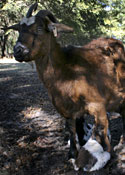 | | Spanish doe |
Spanish or Brush Goat: Descended from the first goats brought over to the Americas by early explorers as a source of meat, these goats are not really a specific breed and there is no registry for these animals. Many of these goats became feral after being released or escaping from the early settlers. These goats come in many colors, sizes, and have varying types of horns.
Tennessee Fainting Goat: Also called Myotonic goats and Tennessee Meat Goats. These goats don't actually faint, but because of a recessive gene that causes a chemical imbalance their muscles and joints stiffen up when they are frightened. When this happens they usually fall over and lie stiff for a few seconds. Babe Howard, founder of the International Goat Days Festival in Millington, Tennessee, discovered his interest in goats through his herd of Tennessee Fainting Goats.
Fiber Breeds
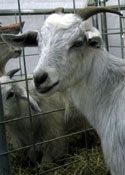 | | Cashmere doe |
Cashmere or Kashmir: Not many people realized that cashmere, that fine and very expensive fiber, comes from goats. In fact, it comes from the undercoat of any number of breeds of long-haired goats, all of which could be considered Cashmere goats. Cashmere goats have two layers of hair: a tough protective overcoat and a soft warm undercoat. The cashmere fiber is often combed out (as opposed to sheared) from the soft undercoat. The cashmere fiber is defined as being less than 19 microns in diameter. Depending on the genetics, a goat can produce as much as 500 grams (or a little more than one pound) of cashmere fiber a year.
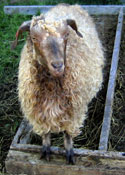 | | Angora doe |
Angora: Unlike Cashmere goats, Angoras are a distinct breed that originated in Turkey (Angora is derived from the name Ankara). Angora goats produce the fiber known as mohair. While mohair is not as fine or as valuable as cashmere, Angora goats can produce much greater quantities of their fiber, up to 10-11 pounds annually. Angora goats are typically white in color, but some breeders, such as Friends' Folly Farm in Winthrop, Maine are actively pursuing darker natural colors. Angora goats usually have short curved horns, and long, curly hair.
Mixed breeds
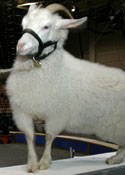 | | Pygora doe |
Pygora: Developed officially in the late 1970s in Oregon (according to the Pygora Breeder's Association) a pygora is a cross between an African Pygmy Goat and an Angora goat. Pygoras come in many colors and can weight anywhere from 65 to 95 pounds. They can produce up to 4 pounds of fleece per year. They are said to be very smart. While Pygoras can be used for fiber or for milk, the Pygoras we met were used for entertainment in a barnyard act at Ringling Bros. and Barnum & Bailey circus.
For more information of these and many other goat breeds, visit:
http://www.ansi.okstate.edu/breeds/goats/
Goat Organizations
All of the following organizations maintain registries for their breeds:
American Dairy Goat Associaiton (ADGA)
American Boer Goat Association (ABGA)
International Boer Goat Associaiton (IBGA)
The American Kiko Goat Association (AKGA)
National Pygmy Goat Associaiton (NPGA)
Nigerian Dwarf Goat Associaiton (NDGA)
Colored Angora Goat Breeders Association (CAGBA)
Pygora Breeders Association
You can find more goat info in our Goat Glossary

|
All content, text and photographs ©2004 The Year of the Goat
This site is powered by Movable Type
Web site design by Karl Schatz
|

|

|
